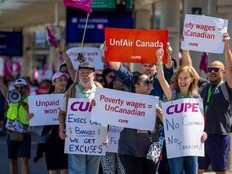Funding, procurement backlogs challenge Carney's defence spending pledge
PM Carney vows Canada's defence spending will meet NATO's 2% benchmark this year, but it may be easier said than done

Article content
OTTAWA — The devil’s always in the details.
That’s what observers are saying about Prime Minister Mark Carney’s pledge Monday to bring Canada’s defence spending above NATO’s minimum benchmark of 2% of GDP — a goal that’s being applauded, but has pundits wondering where the money’s going to come from.
“Debt interest charges already cost taxpayers $1 billion every week, so the government must find big savings in other areas of the budget to offset the higher defence spending,” said Franco Terrazzano, Federal Director of the Canadian Taxpayers Federation.
Even the Conservatives, who’ve spent the past decade criticizing Liberal government spending, had good things to say about Carney’s plan to reverse nearly 10 years of letting Canada’s military rot — but said the announcement means little without knowing where the money’s coming from.
“We want more money for defence, we want to rebuild our armed forces — but we want value for money,” Tory Leader Pierre Poilievre said Tuesday ahead of Question Period — referencing Tuesday’s auditor general report on Canada’s bungled fighter jet procurement, describing costs to purchase 88 F-35s growing by 50% amid pilot shortages and project delays.
“Is the goal to push out as much money as possible, or is the goal to have the best-equipped, best-trained and the best quality-of-life for our military?”
That came one day after Poilievre said the announcement makes the need for an early budget even more critical, something Terrazzano agrees with.
“Canadians deserve to know how much the government is borrowing this year and what savings the government is going to find to pay for all this new spending,” he said.
Defence analyst and Macdonald-Laurier Institute Senior Fellow Richard Shimooka told the Toronto Sun increasing spending isn’t as simple as making an announcement — particularly with Canada’s ongoing procurement bottlenecks.
“There’s just not enough people within the Department of National Defense to actually execute anything except for a couple of programs … especially how process-driven the Government of Canada is,” he said, referencing the auditor’s fighter jet report.
“The fighters’ costs haven’t changed in the past 15 years, just getting this process through is the real issue.”
Making this a priority straight from the PMO may foster enough political will to unblock the logjam, he said, but said it’s impossible to spend money when nobody’s there to draft requests for proposals.
“It’s going to be a challenge to get it going,” he said.
bpassifiume@postmedia.com
X: @bryanpassifiume













Postmedia is committed to maintaining a lively but civil forum for discussion. Please keep comments relevant and respectful. Comments may take up to an hour to appear on the site. You will receive an email if there is a reply to your comment, an update to a thread you follow or if a user you follow comments. Visit our Community Guidelines for more information.